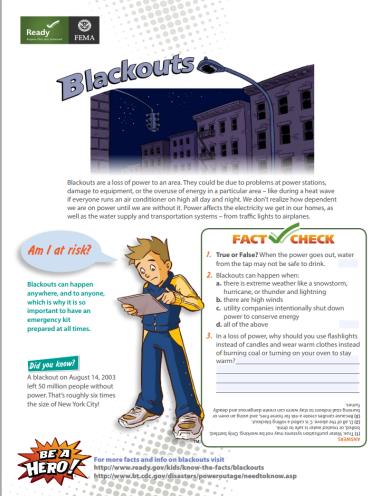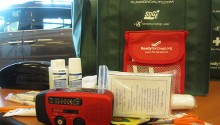Power Outage
What is an Unplanned Outage?
Unplanned outages can be caused by many things; traffic accidents, damage to power lines, and most commonly storms and high winds. If your power goes out unexpectedly, the first thing to do is check your circuit breaker or fuses. If you're circuits and fuses are properly connected, call SDG&E at 1-800-611-7343 to report the outage.
For more information on the status of unplanned power outages and estimated restoration times, visit SDG&E’s Outage Map.
Planned Outages
In order to make necessary system upgrades to improve electric service, SDG&E must schedule interruptions in service to perform the work. Affected residents will be notified in advance of their service being interrupted.
Follow these tips to prepare for a planned outage.
Understanding Outages

Hazardous weather conditions and high winds are two of the common causes of power outages. SDG&E monitors these conditions.
High winds associated with a Red Flag Warning could cause outages or require SDG&E to turn off power for public safety. If outages do occur, the power will stay off until it can be restored safely. During an outage, estimated power restoration information is updated as it becomes available.
Rotating Status Outages - Regional power emergencies sometimes require rotating outages to conserve energy.
Reporting an Outage
Call SDG&E at 1-800-611-7343 to report an outage. When you call to report an outage you will be asked for the following information:
- Your name, address and phone number
- The time the power was interrupted
- If it’s just your power or the entire area
- If you saw or heard anything unusual when the power went out
- If you can see any power lines on the ground
Family Readiness
It is important to for you and your family to plan in advance, to know how you will communicate and meet during and after disasters, and what you will do in different situations. The Family Disaster Plan and Personal Survival Guide is designed to help families be prepared in the event of disaster.
Stay Informed
AlertSanDiego
Sign up for the County’s regional notification system to get alerts via telephone, text, and email with important emergency and disaster information. Get signed up. Get notified.
SD Emergency Mobile App
The must –have preparedness app. The SD Emergency App contains disaster preparedness information, interactive checklists to help you to create an emergency plan, build an emergency supplies kit; and when disaster strikes, the SD Emergency App will keep you and your family informed with emergency updates, interactive emergency maps, and shelter locations.
Download the app today for your iPhone (via the App Store) or Android (via the Google Play Store).
Power Outage Preparedness and Response
Before a Power Outage

- Build or restock your emergency preparedness kit, including a flashlight, batteries, cash, and first aid supplies.
- Know how to Shut Off Your Electricity Safely.
- Know how to Keep Food Safe During an Emergency.
- Keep at least ¼-½ tank of gas in your car at all times.
- Charge mobile devices (cell phone, laptop, and other mobile devices) so they’ll have the maximum amount of battery power stored in the event of a power outage.
- Choose the right backup generator.
During a Power Outage:
- Only use flashlights for emergency lighting, candles can cause fires.
- Conserve your cell phone battery by reducing the brightness of your screen, placing your phone in airplane mode, and closing apps you are not using that draw power.
- Keep refrigerator and freezer doors closed. Most food requiring refrigeration can be kept safely in a closed refrigerator for several hours. An unopened refrigerator will keep food for about 4 hours. A full freezer will keep the temperature for about 48 hours.
- Turn off major appliances like dishwasher or A/C that were running when the power went out to prevent them from starting unexpectedly when power is restored
- Turn off or disconnect appliances and other equipment (TVs, computers, stereos, or game systems) in case of a momentary power â surgeâ that can cause damage. Consider adding surge protectors.
- Leave one light on so you know when power is restored
- Fill an ice chest and place food that needs to be kept inside.
- Listen to a radio in order to remain informed about the causes of the outage and when the power is expected to return.
- Take steps to remain cool if it is hot outside. In intense heat when the power may be off for a long time, consider going to a movie theater, shopping mall or â cooling shelterâ that may be open in your community. If you remain at home, move to the lowest level of your home, since cool air falls. Wear lightweight, light- clothing. Drink plenty of water, even if you do not feel thirsty.
- Put on layers of warm clothing if it is outside. Never burn charcoal for heating or cooking indoors. Never use your oven as a source of heat. If the power may be out for a prolonged period, plan to go to another location (the home of a relative or friend, or a public facility) that has heat to keep warm.
- Only use generators away from your home and NEVER run a generator inside a home or garage, or connect it to your home's electrical system. If using a generator, follow these safety tips.
After a Power Outage
- Throw away any food that has been exposed to temperatures 40° F (4° C) for 2 hours or more or that has an unusual odor, color or texture. When in doubt, throw it out!
- Restock your emergency kit with fresh batteries, canned foods and other supplies


Stay Informed